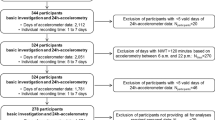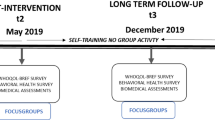Abstract
Objective:
Research on the impact of maternal physical activity on pregnancy outcomes has often employed subjective measures of physical activity obtained by diary or questionnaire. This study investigates the feasibility of using accelerometry as an objective measure of physical activity of pregnant women compared with subjective data obtained via activity recall among pregnant women.
Design:
Activity data were collected prospectively on 57 women at 12, 16, 25, 34 and 38 weeks of gestation. Total daily physical activity was assessed by ambulatory accelerometer and activity interview (self-report). Maternal personality variables (health value, extroversion) were assessed by established scales.
Setting:
Leicestershire, UK.
Subjects:
Pregnant women were recruited by voluntary participation via antenatal booking clinics. In all, 64 pregnant women with low-risk pregnancy were enrolled onto the study, of whom 57 completed the study.
Results:
Mean 24 h physical activity levels (PAL) decreased significantly from second to third trimester as assessed by self-report interview (1.51–1.29 Metabolic Equivalent TEE-h/day, P<0.01) and accelerometry (200.05–147.42 counts/min, P<0.01). The correlation between the two measures declined as pregnancy progressed (r value ranging from 0.55 to 0.08). Compliance with the accelerometers declined from 90% at 12 weeks to 47% at 34 weeks (P<0.01). Compliance with the self-report interviews was 100%. Those who fully complied with the accelerometry demonstrated a significantly higher health value (P<0.05) and a significantly greater level of extroversion (P<0.05) than those who did not.
Conclusions:
Accelerometers and self-reported activity interviews both indicated a significant decline in PAL during pregnancy. Although subjects showed a willingness to use both methods, accelerometers resulted in variable compliance with 72 h monitoring. Both techniques may be limited by the need to measure low levels of physical activity during the third trimester.
Sponsorship:
Cambridge Neurotechnology Ltd, UK, assisted with the provision of Actiwatch accelerometers.
This is a preview of subscription content, access via your institution
Access options
Subscribe to this journal
Receive 12 print issues and online access
$259.00 per year
only $21.58 per issue
Buy this article
- Purchase on Springer Link
- Instant access to full article PDF
Prices may be subject to local taxes which are calculated during checkout
Similar content being viewed by others
References
Ainsworth BE, Haskell WL, Leon AS, Jacobs DR (1993). Compendium of physical activities: classification of energy costs of human physical activities. Med Sci Sports Exerc 25, 71–80.
Allied Dunbar Assurance Plc, Health Education Authority and Sports Council (1992). Allied Dunbar National Fitness Survey. Sports Council and Health Education Authority: London. pp 9–29.
Avons P, Garthwaite P, Davies HL, Murgatroyd PR (1988). Approaches to estimating physical activity in the community: calorimetric validation of actometers and heart rate monitoring. Eur J Clin Nutr 42, 185–196.
Bassett DR (2000). Validity and reliability issues in objective monitoring of physical activity. Res Q Exercise Sport 71, 30–36.
Bouchard C (1983). A method to assess energy expenditure in children and adults. Am J Clin Nutr 37, 461–467.
Bouten CV, Verboeket-Van De Venne WP, Westerterp KR, Verduin M, Janssen JD (1996). Daily physical activity assessment:comparison between movement registration and doubly labeled water. J Appl Physiol 81, 1019–1026.
Bouten CV, Westerterp KR, Verduin M, Janssen JD (1994). Assessment of energy expenditure for physical activity using a triaxial accelerometer. Med Sci Sport Exerc 26, 1516–1523.
Chasan-Taber L, Schmidt MD, Roberts DE, Hosmer D, Markenson G, Freedson PS (2004). Development and validation of a pregnancy physical activity questionnaire. Med Sci Sport Exerc 36, 1750–1760.
Clapp JF, Little KD (1995). Effect of recreational exercise on pregnancy weight gain and subcutaneous fat deposition. Med Sci Sport Exerc 27, 170–177.
Clarke PE (2001). Maternal daily activity in low risk pregnancy: a longitudinal study Doctoral Dissertation, Loughborough University, Loughborough, UK.
Clarke PE, Rousham EK, Gross H, Halligan AWF, Bosio P (2005). Activity patterns and time allocation during pregnancy: a longitudinal study of British women. Ann Hum Biol 32, 247–258.
Conway JM, Seale JL, Jacobs DR, Irwin ML, Ainsworth BE (2002). Comparison of energy expenditure estimates form doubly labelled water, a physical activity questionnaire, and physical activity records. Am J Clin Nutr 75, 519–525.
Eysenck HJ, Eysenck SBG (1975). Manual for the Eysenck Personality Inventory. Hodder and Stoughton: London, P 18.
Fortier I, Marcoux S, Brisson J (1995). Maternal work during pregnancy and the risk of delivering a small for gestational age or preterm infant. Scand J Work Environ Health 21, 412–418.
Freedson PS, Melanson E, Sirard J (1998). Calibration of the Computer Science and Applications, Inc. accelerometer. Med Sci Sports Exerc 30, 777–781.
Goldberg G, Prentice AM, Coward WA, Davies HL, Murgatroyd PR, Wensing C et al. (1993). Longitudinal assessment of energy expenditure in pregnancy by the doubly labelled water method. Am J Clin Nutr 57, 494–505.
Hendelman D, Miller K, Baggett C, Debold E, Freedson P (2000). Validity of accelerometry for the assessment of moderate intensity physical activity in the field. Med Sci Sports Exerc 32, S442–S449.
Hoos MB, Kuipers H, Gerver W-JM, Westerterp KR (2004). Physical activity pattern of children assessed by triaxial accelerometry. Eur J Clin Nutr 58, 1425–1428.
Jacobs DR (2000). Comment on issues in the assessment of physical activity in women. Res Q Exercise Sport 71, 43–46.
Klebanoff MA, Shiono PH, Rhoads GG (1990). Outcomes of pregnancy in a national sample of resident physicians. New Engl J Med 323, 1040–1045.
Kriska AM, Caspersen CJ (1997). A collection of physical activity questionnaires for health related research. Med Sci Sport Exerc 29, S5–S9.
Lau RR, Hartman KA, Ware JE (1986). Health as a value: methodological and theoretical considerations. Health Psychol 5, 25–43.
Luke B, Mamelle N, Keith L, Munoz F, Minogue J, Papiernik E et al. (1995). The association between occupational factors and preterm birth; a United States nurses study. Am J Obstet Gynaecol 173, 849–862.
Meijer GAL, Westerterp KR, Verheven FM, Koper HB (1991). Methods to assess physical activity with special reference to motion sensors and accelerometers. IEEE Tran Bio-Med Eng 38, 221–229.
Meijer GAL, Westerterp KR, Koper H, Ten Hoor F (1989). Assessment of energy expenditure by recording heart rate and body acceleration. Med Sci Sport Exerc 21, 343–347.
Mottola MF, Campbell MK (2003). Activity patterns during pregnancy. Can J Appl Physiol 28, 642–653.
Pols MA, Peeters PHM, Bueno-D-Mesquita BH, Ocke MC (1995). Validity and repeatability of a modified Baecke questionnaire on physical activity. Int J Epidemiol 24, 381–388.
Rabkin CS, Anderson HR, Bland JM, Brooke OG (1990). Maternal activity and birthweight: a prospective population-based study. Am J Epidemiol 131, 522–531.
Schutz Y, Froidevaux F, Jequier E (1988). Estimation of 24 h energy expenditure by a portable accelerometer. P Nutr Soc 47, 23A.
Shinkoda H, Matsumoto K, Park YM (1999). Changes in the sleep–wake cycle during the period from late pregnancy to puerperium identified through the wrist actigraph and sleep logs. Psychiat Clin Neuros 53, 133–135.
Stein AD, Rivera JM, Pivarnik JM (2003). Measuring energy expenditure in habitually active and sedentary pregnant women. Med Sci Sport Exerc 35, 1441–1446.
Sternfeld B (1997). Physical activity and pregnancy outcome. Review and recommendations. Sports Med 23, 33–47.
Sternfeld B, Ainsworth B, Quesenberry CP (1999). Physical activity patterns in a diverse population of women. Prev Med 28, 313–323.
Swartz AM, Strath SJ, Bassett DR, O'Brien WL, King GA, Ainsworth BE (2000). Estimation of energy expenditure using CSA accelerometers at hip and wrist sites. Med Sci Sport Exerc 32, S450–S456.
Van Raaij JMA, Schonk CM, Vermaat-Miedema SH, Peek MEM, Hautvast JGAJ (1990). Energy cost of physical activity throughout pregnancy and the first year postpartum in Dutch women with sedentary lifestyles. Am J Clin Nutr 52, 234–239.
Westerkerp KR (1999). Physical activity assessment with accelerometers. Int J Obes Relat Metab Disord 23, S45–S49.
Zhang J, Savitz DA (1995). Exercise during pregnancy among US women. Ann Epidemiol 6, 53–59.
Acknowledgements
This study was funded by Loughborough University. Grateful thanks are extended to Cambridge Neurotechnology Ltd, Cambridge, UK for the supply of equipment.
Author information
Authors and Affiliations
Corresponding author
Additional information
Guarantor: P Clarke.
Contributors: PEC collected data and carried out the statistical analysis, EKR worked on the study design, data analysis and writing of the paper, HG worked on the study design and the psychological assessment and analysis.
Rights and permissions
About this article
Cite this article
Rousham, E., Clarke, P. & Gross, H. Significant changes in physical activity among pregnant women in the UK as assessed by accelerometry and self-reported activity. Eur J Clin Nutr 60, 393–400 (2006). https://doi.org/10.1038/sj.ejcn.1602329
Received:
Revised:
Accepted:
Published:
Issue Date:
DOI: https://doi.org/10.1038/sj.ejcn.1602329
Keywords
This article is cited by
-
Less sedentary time is associated with a more favourable glucose-insulin axis in obese pregnant women—a secondary analysis of the DALI study
International Journal of Obesity (2021)
-
Effects of a lifestyle intervention in routine care on prenatal physical activity – findings from the cluster-randomised GeliS trial
BMC Pregnancy and Childbirth (2019)
-
Comparison and validation of accelerometer wear time and non-wear time algorithms for assessing physical activity levels in children and adolescents
BMC Medical Research Methodology (2019)
-
The Association between Neighborhood Environments and Physical Activity from Pregnancy to Postpartum: a Prospective Cohort Study
Journal of Urban Health (2019)
-
MET-values of standardised activities in relation to body fat: studies in pregnant and non-pregnant women
Nutrition & Metabolism (2018)



